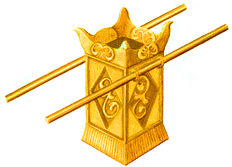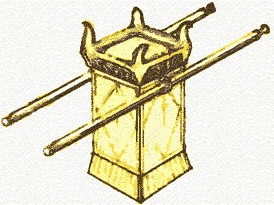The Golden Altar of Incense (Ex 30:1-10)

The Golden Altar of Incense was 2 cubits tall.
It was 1 cubit square with a crown of
gold around the top and it had 4 golden
horns
![]() It
was the Golden Altar of Incense which was straight ahead, before
the veil, this third piece of furniture in the Holy Place on which the holy
incense was burned. Made from
acacia wood overlaid with pure gold it stood higher than any other article
of furniture in the holy place, 2 cubits (3 feet) tall. It was one
cubit square and it had around the top a crown of gold. It had
four golden horns just as
the bronze altar in the courtyard. Lower down on each side there were golden
rings to insert the
poles for carrying.
It
was the Golden Altar of Incense which was straight ahead, before
the veil, this third piece of furniture in the Holy Place on which the holy
incense was burned. Made from
acacia wood overlaid with pure gold it stood higher than any other article
of furniture in the holy place, 2 cubits (3 feet) tall. It was one
cubit square and it had around the top a crown of gold. It had
four golden horns just as
the bronze altar in the courtyard. Lower down on each side there were golden
rings to insert the
poles for carrying.
- It had 4 horns of gold, one with it, a horn on each corner. (4-camps, e.Judah, s.Ruben, w.Ephraim, n.Dan, all Gods people)
The golden altar was used for burning incense, which twice every day was offered by the priest after he had tended the wick and oil on the holy lamps. Its horns were also sprinkled with the blood of the sin offering.
The incense was a mixture of three rich and rare spices, which cannot be identified today. These were blended with frankincense and beaten to a fine powder and then salt was added. It was totally forbidden for this formula to be used by any private individual. It had to be used only in the worship of God in the holy place.
Ex 30:34-38 And the LORD said to Moses: "Take sweet spices, stacte and onycha and galbanum, and pure frankincense with these sweet spices; there shall be equal amounts of each. You shall make of these an incense, a compound according to the art of the perfumer, salted, pure, and holy. And you shall beat some of it very fine, and put some of it before the Testimony in the tabernacle of meeting where I will meet with you. It shall be most holy to you. But as for the incense which you shall make, you shall not make any for yourselves, according to its composition. It shall be to you holy for the LORD. Whoever makes any like it, to smell it, he shall be cut off from his people."
The incense was burnt on pieces of hot coal, which the priest removed in a censer or fire pan from the altar of burnt offering in the courtyard. A censer apparently was a shallow bowl or pan with a handle on it. It could be also be used for removing the ashes from the altar or gathering up the burnt parts of the wick from the lampstand.

The golden altar was used for burning incense
Poured out on burning coals the incense produced a delightful aroma in the Holy Place. It was the offering of the person whose sins had been forgiven by blood and who then went on to express the fragrance of love and worship, which was most pleasing to God.
The Golden Altar speaks to us of the worship of Jesus Christ and God's people through him as our high priest and mediator. It was only on the basis of His one sacrifice on the altar of the cross that worship is made possible. The coals, which lit the incense, was carried from the altar of sacrifice to the altar of incense.
Although the common priest would burn these holy spices on the altar over 700 times in a year he knew that no priest other than the High Priest could go beyond that point, and only on the Day of Atonement.
Lev 16:12 "Then Aaron shall take a censer full of burning coals of fire from the altar before the LORD, with his hands full of sweet incense beaten fine, and bring it inside the veil.
- The sweet incense was to be kept burning at all times.
- It was before the veil, and the throne of God (Jesus for us)On The Journey
Num 4:11 "Over the golden altar they shall spread a blue cloth, and cover it with a covering of badger skins; and they shall insert its poles.
Example of Moses' intercession:
Num 16:41-50 On the next day all the congregation of the children of Israel murmured against Moses and Aaron, saying, "You have killed the people of the LORD." Now it happened, when the congregation had gathered against Moses and Aaron, that they turned toward the tabernacle of meeting; and suddenly the cloud covered it, and the glory of the LORD appeared. Then Moses and Aaron came before the tabernacle of meeting. And the LORD spoke to Moses, saying, "Get away from among this congregation, that I may consume them in a moment." And they fell on their faces. So Moses said to Aaron, "Take a censer and put fire in it from the altar, put incense on it, and take it quickly to the congregation and make atonement for them; for wrath has gone out from the LORD. The plague has begun." Then Aaron took it as Moses commanded, and ran into the midst of the assembly; and already the plague had begun among the people. So he put in the incense and made atonement for the people. And he stood between the dead and the living; so the plague was stopped. Now those who died in the plague were fourteen thousand seven hundred, besides those who died in the Korah incident. So Aaron returned to Moses at the door of the tabernacle of meeting, for the plague had stopped.
 A Type of Christ
A Type of Christ
The golden altar of incense tells us of the ministry of Jesus as our intercessor whose prayers never stop ascending to God on our behalf. Jesus said to Peter, "I have prayed for you." The four horns speak of Christ's ministry extending to the four corners of the earth. He will always pray for His own no matter where they are. He can intercede on our behalf because of the atoning work on the cross of Calvary. The incense was fueled by the fire from the altar. It is not just anyone praying for us but the King Himself as represented by the crown of gold. He knows our weaknesses and our failings and He is praying for us always.
Ps 141:2 Let my prayer be set before You as incense, the lifting up of my hands as the evening sacrifice.
Jn 17:9-10 "I pray for them. I do not pray for the world but for those whom You have given Me, for they are Yours. And all Mine are Yours, and Yours are Mine, and I am glorified in them.
Luke 22:31-32 And the Lord said, "Simon, Simon! Indeed, Satan has asked for you, that he may sift you as wheat. But I have prayed for you, that your faith should not fail; and when you have returned to Me, strengthen your brethren."
John 17:15 "I do not pray that You should take them out of the world, but that You should keep them from the evil one.
Heb 7:25 Therefore He is also able to save to the uttermost those who come to God through Him, since He always lives to make intercession for them.
1 Jn 2:1 My little children, these things I write to you, so that you may not sin. And if anyone sins, we have an Advocate with the Father, Jesus Christ the righteous.
Lk 22:31-32 And the Lord said, "Simon, Simon! Indeed, Satan has asked for you, that he may sift you as wheat. "But I have prayed for you, that your faith should not fail; and when you have returned to Me, strengthen your brethren."
Rom 8:26-27 Likewise the Spirit also helps in our weaknesses. For we do not know what we should pray for as we ought, but the Spirit Himself makes intercession for us with groanings which cannot be uttered. Now He who searches the hearts knows what the mind of the Spirit is, because He makes intercession for the saints according to the will of God.
Ps 121:4 Behold, He who keeps Israel shall neither slumber nor sleep.
Heb 4:16 Let us therefore come boldly to the throne of grace, that we may obtain mercy and find grace to help in time of need.
Rom 8:34 It is Christ who died, and furthermore is also risen, who is even at the right hand of God, who also makes intercession for us.
Acts 6:4 "but we will give ourselves continually to prayer and to the ministry of the word."
Heb 13:15 Therefore by Him let us continually offer the sacrifice of praise to God, that is, the fruit of our lips, giving thanks to His name.
Lk 1:8-10 So it was, that while he was serving as priest before God in the order of his division, according to the custom of the priesthood, his lot fell to burn incense when he went into the temple of the Lord. And the whole multitude of the people was praying outside at the hour of incense.
Rev 5:8 Now when He had taken the scroll, the four living creatures and the twenty-four elders fell down before the Lamb, each having a harp, and golden bowls full of incense, which are the prayers of the saints.
Rev 8:3-4 Then another angel, having a golden censer, came and stood at the
altar. And he was given much incense, that he should offer it with the prayers
of all the saints upon the golden altar which was before the throne. And the
smoke of the incense, with the prayers of the saints, ascended before God from
the angel's hand.
The golden altar of incense tells us of the ministry of Jesus as our intercessor whose prayers never stop ascending to God for us.

Read The Bible
- 1599 Geneva Bible (GNV)
- 21st Century King James Version (KJ21)
- American Standard Version (ASV)
- Amplified Bible (AMP)
- Amplified Bible, Classic Edition (AMPC)
- Authorized (King James) Version (AKJV)
- BRG Bible (BRG)
- Christian Standard Bible (CSB)
- Common English Bible (CEB)
- Complete Jewish Bible (CJB)
- Contemporary English Version (CEV)
- Darby Translation (DARBY)
- Disciples’ Literal New Testament (DLNT)
- Douay-Rheims 1899 American Edition (DRA)
- Easy-to-Read Version (ERV)
- English Standard Version (ESV)
- English Standard Version Anglicised (ESVUK)
- Evangelical Heritage Version (EHV)
- Expanded Bible (EXB)
- GOD’S WORD Translation (GW)
- Good News Translation (GNT)
- Holman Christian Standard Bible (HCSB)
- International Children’s Bible (ICB)
- International Standard Version (ISV)
- J.B. Phillips New Testament (PHILLIPS)
- Jubilee Bible 2000 (JUB)
- King James Version (KJV)
- Lexham English Bible (LEB)
- Living Bible (TLB)
- Modern English Version (MEV)
- Mounce Reverse Interlinear New Testament (MOUNCE)
- Names of God Bible (NOG)
- New American Bible (Revised Edition) (NABRE)
- New American Standard Bible (NASB)
- New American Standard Bible 1995 (NASB1995)
- New Catholic Bible (NCB)
- New Century Version (NCV)
- New English Translation (NET)
- New International Reader's Version (NIRV)
- New International Version - UK (NIVUK)
- New International Version (NIV)
- New King James Version (NKJV)
- New Life Version (NLV)
- New Living Translation (NLT)
- New Matthew Bible (NMB)
- New Revised Standard Version (NRSV)
- New Revised Standard Version Catholic Edition (NRSVCE)
- New Revised Standard Version, Anglicised (NRSVA)
- New Revised Standard Version, Anglicised Catholic Edition (NRSVACE)
- New Testament for Everyone (NTE)
- Orthodox Jewish Bible (OJB)
- Revised Geneva Translation (RGT)
- Revised Standard Version (RSV)
- Revised Standard Version Catholic Edition (RSVCE)
- The Message (MSG)
- The Voice (VOICE)
- Tree of Life Version (TLV)
- World English Bible (WEB)
- Worldwide English (New Testament) (WE)
- Wycliffe Bible (WYC)
- Young's Literal Translation (YLT)
Table of Contents
Main Menu
- Ancient Assyrian Social Structure
- Ancient Babylonia
- Ancient Canaan During the Time of Joshua
- Ancient History Timeline
- Ancient Oil Lamps
- Antonia Fortress
- Archaeology of Ancient Assyria
- Assyria and Bible Prophecy
- Augustus Caesar
- Background Bible Study
- Bible
- Biblical Geography
- Fallen Empires - Archaeological Discoveries and the Bible
- First Century Jerusalem
- Glossary of Latin Words
- Herod Agrippa I
- Herod Antipas
- Herod the Great
- Herod's Temple
- High Priest's in New Testament Times
- Jewish Literature in New Testament Times
- Library collection
- Map of David's Kingdom
- Map of the Divided Kingdom - Israel and Judah
- Map of the Ministry of Jesus
- Matthew Henry Bible Commentary
- Messianic Prophecy
- Nero Caesar Emperor
- Online Bible Maps
- Paul's First Missionary Journey
- Paul's Second Missionary Journey
- Paul's Third Missionary Journey
- Pontius Pilate
- Questions About the Ancient World
- Tabernacle of Ancient Israel
- Tax Collectors in New Testament Times
- The Babylonian Captivity
- The Black Obelisk of Shalmaneser
- The Books of the New Testament
- The Court of the Gentiles
- The Court of the Women in the Temple
- The Destruction of Israel
- The Fall of Judah with Map
- The History Of Rome
- The Incredible Bible
- The Jewish Calendar in Ancient Hebrew History
- The Life of Jesus in Chronological Order
- The Life of Jesus in Harmony
- The Names of God
- The New Testament
- The Old Testament
- The Passion of the Christ
- The Pharisees
- The Sacred Year of Israel in New Testament Times
- The Samaritans
- The Scribes
Ancient Questions
- Why Do the Huldah Gates Appear Different in Ancient Replicas and Modern Photos?
- What Is the Origin of the Japanese and Chinese Peoples? A Biblical Perspective
- How did the ancient Greeks and Romans practice medicine and treat illnesses?
- What were the major contributions of ancient Babylon to mathematics and astronomy?
- How did the ancient Persians create and administer their vast empire?
- What were the cultural and artistic achievements of ancient India, particularly during the Gupta Empire?
- How did ancient civilizations like the Incas and Aztecs build their remarkable cities and structures?
- What were the major trade routes and trading practices of the ancient world?
- What was the role of slavery in ancient societies like Rome and Greece?
- How did the ancient Mayans develop their sophisticated calendar system?
Bible Study Questions
- Why Do Christians Celebrate Christmas?
- How Many Chapters Are There in the Bible?
- The Five Key Visions in the New Testament
- The 400-Year Prophecy: Unpacking Genesis 15 and the Journey of a People
- The Authorized (King James) Version (AKJV): Historical Significance, Translation Methodology, and Lasting Impact
- Exploring the English Standard Version (ESV): Its Aspects, Comparisons, Impact on Biblical Studies, and Church Use
- A Detailed Historical Analysis of Language Updates in the KJ21: Comparison with Other Versions
- A Detailed Historical Analysis of the American Standard Version (ASV): Comparison to the King James Version, Influence on Later Translations, and Evaluation of Strengths and Weaknesses
- A Detailed Historical Analysis of Amplifications in the Amplified Bible (AMP) and Its Comparison to Other Bible Translations
- Detailed Historical Analysis of the Amplified Bible Classic Edition (AMPC): Examples of Amplifications and Comparative Analysis with Other Bible Translations
About
Welcome to Free Bible: Unearthing the Past, Illuminating the Present! Step into a world where ancient history and biblical narratives intertwine, inviting you to explore the rich tapestry of human civilization.
Discover the captivating stories of forgotten empires, delve into the customs and cultures of our ancestors, and witness the remarkable findings unearthed by dedicated archaeologists.
Immerse yourself in a treasure trove of knowledge, where the past comes alive and illuminates our understanding of the present.
Join us on this extraordinary journey through time, where curiosity is rewarded and ancient mysteries await your exploration.
Recent posts
-

Best gemstones for stud earrings for 15 years girl
Selecting the perfect pair of stud earrings for a 15-year-old girl is an exciting yet thoughtful process. Stud earrings are a timeless accessory, offe... -

Prayers for Prophets: A Reflection on Reverence and Intercession
Prophets hold a revered status across many of the world’s major religions. As individuals chosen to convey divine messages, they are often remembere... -

How Machine Learning is Reducing Risk in Automated Trading
In today’s fast-paced monetary markets, automated buying and selling has come to be a cornerstone of current making an investment. Algorithms now ex... -

Timur Turlov: Driving Global Investment Innovation Through Freedom Holding Corp.
Timur Turlov leads Freedom Holding Corp. (NASDAQ: FRHC) as its CEO where he connects technology with finance and global markets. Turlov established Fr... -

AI in the Legal Industry: Can Algorithms Replace Lawyers?
The legal career is historically considered as a discipline rooted in human judgment, nuance, and vital questioning. But in recent years, Artificial I...





